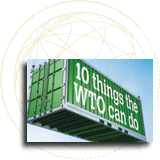- home
- the wto
- what is the wto?
- 10 things
- be effective without hitting the headlines
The WTO can ...
...cut living costs and raise living standards
...settle disputes and reduce trade tensions
...stimulate economic growth and employment
...cut the cost of doing business internationally
...encourage good governance
...help countries develop
...give the weak a stronger voice
...support the environment and health
...contribute to peace and stability
...be effective without hitting the headlines
Section 1 “...cut living costs and raise living standards”
- Figures on impact of liberalization in the US — John Veroneau, “Introduction”, and Why Christina R. Sevilla, “Liberalize Trade?”, in Economic Perspectives, January 2007, Volume 12, Number 1, US Department Of State, pages 2 and 4.
- Figures on impact of liberalization in the EU — European Commission, Trade, Growth and World Affairs: Trade Policy as a Core Component of the EU’s 2020 Strategy, November 2010, page 5
- Figures in “Food is cheaper”, “clothes are cheaper” — 10 benefits of the WTO trading system (no longer published)
- Figures in “The same goes for other goods” — Bruce Stokes, “Protectionism and Politics” in Economic Perspectives, January 2007, Volume 12, Number 1, US Department Of State, page 9
- Figures on services — Information and communications technology (ITC) data Measuring the Information Society 2011, International Telecommunications Union, 2011
- Box “points of view” on food security — Olivier de Schutter: Food security hostage to trade in WTO negotiations — UN right to food expert, www.ohchr.org/en/NewsEvents/Pages/DisplayNews.aspx?NewsID=11608&LangID=E accessed June 2012
— Gawain Kripke, Finding some focus: Trade and food security, the Politics of Poverty, Oxfam America, 6 June 2012. http://politicsofpoverty.oxfamamerica.org/2012/06/06/finding-some-focus-trade-and-food-security/ (accessed June 2012)
— Pascal Lamy, letter to Olivier de Schutter, 14 December 2011, www.2n2y.com/english/news_e/news11_e/agcom_14dec11_e.htm (accessed June 2012)
Section 2 “...settle disputes and reduce trade tensions”
- Boxes on disputes: WTO dispute data, Raúl A Torres, “Use of the WTO Trade Dispute Settlement Mechanism by the Latin American Countries — dispelling myths and breaking down barriers”. WTO Staff Working Paper ERSD-2012-03, February 2012
Section 3 “...stimulate economic growth and employment”
- The OECD has charted the impact of imports on the jobless rate in 23 countries; and Chart: “Imports are no longer linked to job losses” — from Douglas Lippoldt (ed), Policy Priorities for International Trade and Jobs, OECD, 2012, page 22 and OECD Economic Outlook database
- Information and communications technology (ITC) development index and employment figures: Measuring the Information Society 2011, International Telecommunications Union, 2011
Section 4 “...cut the cost of doing business internationally”
- Trade facilitation figures — Moïsé, E., T. Orliac and P. Minor (2011), “Trade Facilitation Indicators: The Impact on Trade Costs”, OECD Trade Policy Working Papers, No. 118, OECD Publishing, http://dx.doi.org/10.1787/5kg6nk654hmr-en; and Pascal Lamy, “WTO trade facilitation deal to reduce trade costs and boost trade”, speech at the World Customs Organization in Brussels on 24 June 2011, http://www.2n2y.com/english/news_e/sppl_e/sppl197_e.htm
- Box “Made in Where?” — Greg Rushford, “Made in America”, Rushford Report, 13 March 2012 http://www.rushfordreport.com/2012/120313—madewhere.htm (requires registration)
Section 5 “...encourage good governance”
- Impact of Government Procurement Agreement: “Historic deal reached on government procurement”, 15 December 2012, http://www.2n2y.com/english/news_e/news11_e/gpro_15dec11_e.htm
Section 6 “...help countries develop”
- Donor countries have committed an average of US$ 40 billion a year to trade-related development programmes — WTO document WT/COMTD/AFT/W/30, 15 November 2011, www.2n2y.com/aidfortrade
- “Points of view”
— Aurelie Walker, “The WTO has failed developing nations”, The Guardian, Poverty Matters Blog, 14 November 2011, http://www.guardian.co.uk/global-development/poverty-matters/2011/nov/14/wto-fails-developing-countries;
— Duncan Green, “Doha round has run its course but new trade realities demand solutions”, The Guardian, Poverty Matters Blog, 4 May 2004, http://www.guardian.co.uk/global-development/poverty-matters/2011/may/04/doha-trade-realities-demand-solutions;
— Kaushik Basu, “Trade and the Third World”, Project Syndicate, 27 March 2002, http://www.project-syndicate.org/commentary/trade-and-the-third-world
Section 7 “...give the weak a stronger voice”
- Legal advice —Advisory Centre on WTO Law www.acwl.ch
Section 8 “...support the environment and health”
- The Marrakesh Agreement Establishing the WTO — http://www.2n2y.com/english/docs_e/legal_e/04-wto_e.htm.
- Box Public goods v. private goods— George Soros, “Fixing, not Sinking, the WTO”, Project Syndicate, 6 November 2001, http://www.project-syndicate.org/commentary/fixing—not-sinking—the-wto
Section 9 “...contribute to peace and stability”
- Chart, “Before”: Protectionism drained away two-thirds of world trade, 1929–33 — : Charles P Kindleberger, The World in Depression 1929–1939, Allen Lane/Penguin, page 172, citing League of Nations Monthly Bulletin of Statistics, February 1934, page 51. (Total imports of 75 countries, monthly values in terms of old US gold dollars.)
- Chart, “After”: History has not been repeated — www.2n2y.com/statistics
Section 10 “...be effective without hitting the headlines”
- 10,000 “notifications” — SPS notifications hit 5 figures and committee wraps up China review, http://www.2n2y.com/english/news_e/news11_e/sps_19oct11_e.htm
